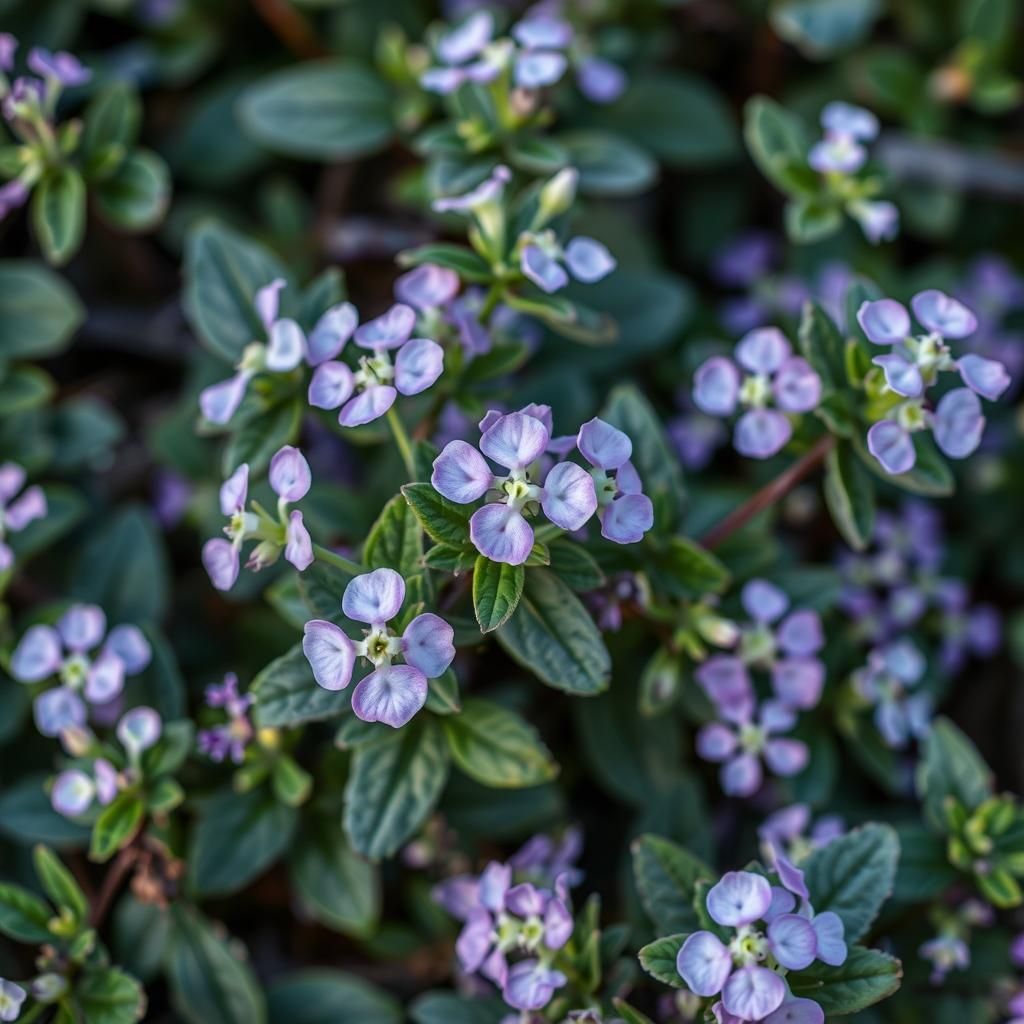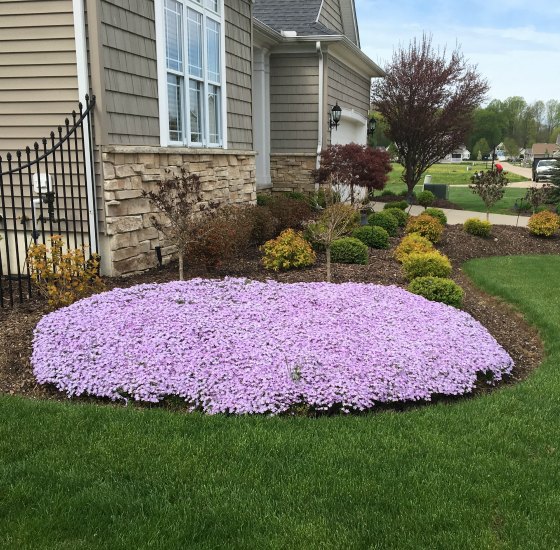What Does Creeping Phlox Look Like When Not in Bloom? A Comprehensive Guide to Its Foliage and Appearance

Creeping phlox, known for its vibrant blooms in spring, presents a different charm when not in flower. Understanding its foliage and overall appearance during this dormant phase reveals a unique aspect of this perennial favorite. This comprehensive guide will delve into the characteristics of creeping phlox in its non-blooming state, including the texture and color of its leaves, growth habit, and how it complements garden landscapes throughout the year. By recognizing these features, gardeners can appreciate the allure of creeping phlox beyond its seasonal blossoms, ensuring it remains a stunning addition to any garden even when it’s not in full bloom.
What is the Appearance of Creeping Phlox When Not in Bloom?
Creeping phlox, known scientifically as Phlox subulata, exhibits a distinctive foliage even when it is not in bloom. The plant has a dense, matted growth habit, characterized by small, evergreen leaves that are needle-like in shape and typically measure about 0.5 to 1 inch long. These leaves form a lush carpet that can spread up to 2 feet wide, making creeping phlox an excellent choice for ground cover. The texture of the foliage is somewhat fuzzy or hairy, giving it a soft appearance. During the non-blooming season, the color of the leaves ranges from vibrant green to a slightly bluish hue, depending on the environmental conditions, which can add visual interest even without the bright flowers.
Foliage Characteristics
The foliage of creeping phlox consists of small, narrow leaves that are densely packed, offering a lush appearance. The leaves are typically around 0.5 to 1 inch in length and have a distinctive green color that can sometimes appear bluish, especially in shaded areas. The soft and somewhat fuzzy texture of the leaves creates a gentle overall look, making them an attractive component of rock gardens, borders, and ground cover.
Growth Habit
Creeping phlox is known for its mounding, mat-forming growth habit. When not in bloom, the plant can spread widely, often reaching up to 2 feet across while maintaining a low profile of about 6 to 12 inches in height. This spreadability allows it to effectively cover soil and suppress weeds, making it not only ornamental but also functional in garden settings.
Seasonal Changes
Throughout the seasons, the appearance of creeping phlox can change significantly, particularly in terms of coloration and growth rate. In spring and summer, the foliage is vibrant and lush, while in the fall, it may take on a more muted tone. In colder months, the plant remains evergreen but may become less dense. These seasonal variations contribute to its overall aesthetic appeal throughout the year.
Comparison with Other Ground Covers
When compared to other popular ground covers, creeping phlox stands out due to its unique foliage and mat-forming characteristics. Unlike traditional grasses or other low-growing flowers, creeping phlox offers a distinctive texture and evergreen quality, making it a more interesting choice for gardeners looking to add variety. Its ability to thrive in different environments further enhances its desirability among landscaping enthusiasts.
Uses in Landscaping
Creeping phlox is often utilized in landscaping as a ground cover, particularly in rock gardens, along borders, and in areas where weed suppression is desired. Its ability to grow in various soil types and its drought tolerance make it a versatile plant for commercial and residential settings. The attractive foliage contributes to its popularity, providing year-round interest beyond its blooming period.
| Foliage Type | Growth Habit | Seasonal Color | Comparative Advantage | Landscaping Use |
|---|---|---|---|---|
| Small, needle-like leaves | Mat-forming | Varies across seasons | Unique texture | Ground cover, rock gardens |
What does creeping phlox look like when it's not blooming?

Creeping phlox, or Phlox subulata, presents a distinct appearance even when it's not in bloom. The foliage of creeping phlox consists of narrow, needle-like leaves that are densely packed together, forming a lush green mat. During the non-blooming season, the plant typically remains low to the ground, rarely exceeding six inches in height. The leaves maintain a vibrant green color, contributing to the landscape by creating a thick carpet effect that can help prevent weed growth.
The stems of crawling phlox are sturdy and can propagate easily through their rhizomatic roots, allowing them to spread significantly over time. This growth pattern often leads to a dense, ground-covering layer that is praised for its drought resistance and low maintenance requirements.
Leaf Structure of Creeping Phlox
The leaf structure of creeping phlox is an essential aspect of its appearance when not blooming. The leaves are:
- Needle-like: They resemble tiny needles, giving the plant a unique texture.
- Dense arrangement: The leaves grow closely together, creating a thick carpet that effectively covers the soil.
- Evergreen: The foliage remains green throughout the year, contributing to year-round visual interest.
Color Changes Throughout the Seasons
While blooming enhances its beauty, creeping phlox maintains a consistent visual appeal through the changing seasons. The color changes include:
- Bright green in spring and summer: The leaves exhibit vibrant shades, adding freshness to the garden.
- Muted tones in fall: As temperatures drop, the foliage may take on slightly darker or muted shades.
- Possible browning in winter: In colder climates, the leaves may brown but typically retain their structure.
Growth Habit and Propagation
The growth habit of creeping phlox is another striking feature when in its non-blooming state. It is characterized by:
See also:
- Low-growing mat: The plant spreads horizontally, providing excellent ground cover.
- Rhizomatic roots: These allow the plant to multiply and cover larger areas over time.
- Resilience: The growth habit enables it to withstand periods of drought and adverse conditions.
Ecological Benefits of Creeping Phlox
Creeping phlox, even when not flowering, offers various ecological benefits that contribute to its overall value in gardens. These include:
- Weed suppression: The dense foliage effectively blocks sunlight, helping prevent weed growth.
- Soil erosion control: Its mat-like structure stabilizes the soil, reducing erosion on slopes.
- Wildlife attraction: The foliage can provide habitat for beneficial insects and small wildlife.
Maintenance Requirements
Despite its stunning appeal, creeping phlox is low maintenance, which is a significant reason for its popularity. The maintenance requirements are:
- Minimal watering: Once established, this plant is quite drought-resistant.
- Rare pruning: Only occasional trimming is necessary to control its spread.
- Soil checks: Ensuring well-drained soil will help maintain its health and vibrancy.
What are the downsides of creeping phlox?

Creeping phlox, known for its vibrant colors and ability to create a lush ground cover, has several downsides that potential gardeners should consider before incorporating it into their landscapes.
Growth Habit
Creeping phlox can spread quite rapidly, which may not always be desirable. While its spreading nature can create a thick carpet of flowers, it can also outcompete other plants in your garden.
- Dominance: Creeping phlox can dominate the space, making it difficult for other plants to thrive.
- Maintenance: Gardeners may need to regularly manage its spread, including uprooting or pruning to control growth.
- Limited Diversity: A single plant type can reduce plant diversity in the garden ecosystem.
Soil Requirements
Creeping phlox prefers certain soil types and conditions that not all gardeners can provide, leading to potential issues with growth and health.
- Drainage: It requires well-draining soil; poor drainage can lead to root rot.
- pH Levels: Ideal pH levels are necessary for optimal growth; acidic or alkaline soils may hinder its development.
- Soil Fertility: It may not thrive in nutrient-poor soils, requiring additional amendments.
Pest and Disease Susceptibility
Creeping phlox can fall victim to various pests and diseases, which may compromise its health and aesthetic appeal.
- Pests: Aphids and spider mites are common foes that can weaken the plant.
- Diseases: Powdery mildew and root rot are concerns, especially in damp, humid conditions.
- Control Measures: Managing these issues can increase the workload for the gardener.
Seasonal Lifespan
Although creeping phlox blooms beautifully in the spring, its foliage may not remain attractive year-round.
- Post-Bloom Foliage: The leaves may turn unattractive after flowering, leading to a less appealing garden.
- Winter Dormancy: It may die back significantly in winter, leaving bare patches.
- Seasonal Interest: Gardeners may need to supplement with other plants to maintain year-round visual interest.
Allergic Reactions
Some individuals may experience allergic reactions to creeping phlox, particularly during its blooming period.
- Pollen Production: The proliferation of pollen can trigger allergies in sensitive individuals.
- Skin Irritation: Handling the plant may cause skin irritation for some gardeners.
- Alternative Options: Those allergic might need to consider alternative ground cover plants.
What months does creeping phlox bloom?

Creeping phlox, scientifically known as Phlox subulata, is a perennial flowering plant that typically blooms in the spring months. This plant is renowned for its vibrant colors and ground-covering abilities. The blooming period for creeping phlox generally spans from April to June, with the peak bloom often occurring in late April to early May, depending on the climate and specific growing conditions.
Blooming Cycle of Creeping Phlox
The blooming cycle of creeping phlox is crucial for gardeners and landscapers who wish to enjoy its vivid flowers. The blooming process can be broken down into several phases:
- Early Growth: In early spring, creeping phlox begins to emerge from dormancy, preparing for its flowering period.
- Bud Development: As temperatures rise in mid-April, buds start to form. This is an important period where proper care can enhance bloom quality.
- Peak Blooming: The plants fully flower during late April to early May, showcasing a vibrant array of colors.
- After Blooming: After the peak period, some flowers may fade, but the foliage remains attractive throughout the summer.
Factors Influencing Bloom Time
Several factors can affect the exact bloom time of creeping phlox. Understanding these can help in planning when to expect the blooms:
See also:
- Climate: Warmer climates often see earlier blooms, while cooler regions may experience delays.
- Soil Quality: Nutrient-rich, well-draining soil promotes healthy growth and timely blooming.
- Watering: Consistent moisture can impact the blooming period; however, overwatering must be avoided.
- Sun Exposure: Creeping phlox thrives in full sun to partial shade, with more sun leading to earlier blooms.
Care During Blooming Season
To ensure a robust flowering season, proper care is essential during the blooming months. Key care tips include:
- Fertilization: Applying a balanced fertilizer in early spring can promote blooms and overall plant health.
- Pruning: Deadheading spent flowers can encourage more blooms and prevent the plant from using energy on dying flowers.
- Pest Management: Regularly inspecting for pests can help maintain the health of blooming plants and enhance their vibrancy.
Color Variations in Creeping Phlox
Creeping phlox comes in a variety of colors that can enhance any landscape. The color variations typically include:
- Pink: A popular choice, bright pink flowers add a cheerful touch to gardens.
- White: White creeping phlox offers a classic, timeless look that can complement other flowers.
- Purple: Deep purple flowers create a striking contrast within garden settings.
- Blue: Bright blue varieties are less common but provide a unique shade to gardens.
Companion Plants for Creeping Phlox
Choosing the right companion plants can enhance the aesthetic appeal of gardens featuring creeping phlox. Recommended companions include:
- Hostas: The foliage of hostas creates a nice contrast with the low-growing creeping phlox.
- Daylilies: These perennials can bloom after phlox, providing continuous color throughout the season.
- Lavender: With similar growth conditions, lavender pairs well with creeping phlox both visually and ecologically.
- Ajuga: This ground cover can complement creeping phlox by filling in spaces between blooms.
How do you keep creeping phlox blooming all summer?

To keep creeping phlox blooming all summer, a combination of proper care, maintenance, and environmental considerations is required. Here are some key strategies to ensure vibrant blooms throughout the season:
1. Ensure Proper Sunlight Exposure
Creeping phlox thrives in areas with full sunlight. To keep your plants blooming, place them in a location that receives at least 6 hours of direct sun each day. If they are in partial shade, consider relocating them.
- Choose a spot with full sunlight for optimum growth.
- Observe the plant's growth throughout the seasons to determine if it needs a sunnier location.
- Avoid areas where other plants may overshadow the phlox, reducing sunlight access.
2. Regular Watering Practices
Consistent watering is vital for maintaining healthy creeping phlox. These plants prefer well-draining soil but need sufficient moisture to produce flowers. Water them regularly, ensuring the soil does not dry out completely.
- Water deeply but infrequently, allowing the soil to slightly dry out between waterings.
- Monitor weather conditions and water more frequently during dry spells.
- Avoid waterlogging, as this can lead to root rot.
3. Fertilization for Continuous Blooming
Using a balanced, slow-release fertilizer can promote lush growth and abundant blooms in creeping phlox. Fertilizing in early spring when the new growth emerges can be particularly effective.
- Apply a balanced fertilizer with equal ratios of nitrogen, phosphorus, and potassium.
- Follow the recommended guidelines on the product for the best results.
- Avoid over-fertilizing, as it can lead to lush foliage with fewer flowers.
4. Pruning and Deadheading Techniques
Regular deadheading encourages new blooms by removing faded flowers. Additionally, light pruning after the first bloom can stimulate further growth and flowering.
- Use sharp, clean tools to deadhead spent flowers immediately after they fade.
- Prune back about one-third of the plant height after the first flowering to promote new growth.
- Monitor the plants for excessive seed formation, as this can deplete energy from blooming.
5. Pest and Disease Management
Keeping creeping phlox healthy involves protecting them against pests and diseases. Regular checks will help you identify problems early and treat them effectively.
- Inspect plants regularly for signs of pests such as aphids or spider mites.
- Implement organic pesticides or insecticidal soaps if infestations occur.
- Ensure good air circulation around the plants to minimize disease risk, particularly powdery mildew.
Questions from Our Readers
What is the appearance of creeping phlox foliage when not in bloom?
When not in bloom, creeping phlox showcases dense, green foliage that forms a low-growing mat. The leaves are needle-like and evergreen, providing a lush backdrop even outside its flowering period.
Can I still recognize creeping phlox without its flowers?
Yes, even without flowers, you can recognize creeping phlox by its unique habit of spreading and its colorful evergreen leaves. The plant tends to create a carpet-like effect, making it distinct among ground covers.
How does the texture of creeping phlox change when not in bloom?
The texture of creeping phlox remains smooth and soft when not in bloom, offering a contrast to many other ground covers. The fine leaves create a pleasant tactile experience, providing both aesthetic and functional appeal in the garden.
See also:
Is the growth habit of creeping phlox consistent throughout the year?
Yes, the growth habit of creeping phlox is consistent year-round, as it tends to spread horizontally and form a tight mat of foliage. Even without flowers, the plant maintains its dense structure, contributing to the overall landscape aesthetics throughout the seasons.

If you want to read more articles like What Does Creeping Phlox Look Like When Not in Bloom? A Comprehensive Guide to Its Foliage and Appearance, we recommend you check out our Plants category.
Leave a Reply
Related Articles